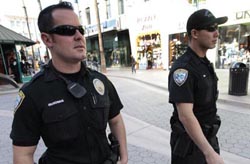Santa Monica Police Chief Tim Jackman has extended for one month a pilot program in which rank-and-file officers work three, 12.5-hour days instead of the traditional 10 hour, four days a week schedule, a move that is expected to raise morale while putting more officers on the streets at times when they are needed most.
Jackman decided to extend the six-month pilot program so that he could do further analysis to see if the switch to 3-12 is working. Preliminary reports show that fatigue has not been a factor and the switch has most likely reduced the need for overtime by about 35 percent, saving taxpayers money. Jackman said he would like more information to determine if the drop in overtime is due to the new work schedule or other factors.

Santa Monica Police Officers Scott McGowan (left) and Michael Chun patrol the Third Street Promenade on Thursday afternoon. Police Chief Tim Jackman has extended for one month a pilot program in which officers work for 12.5 hours a day for three days a week instead of the traditional 10 hours, four days a week. (Photo: Brandon Wise)
"So far, it's looking pretty good," Jackman said of the switch. "But, I want to make sure that I have gathered all the data I can to make a strong presentation to the appropriate folks so that we can make a good, solid decision."
The pilot program is expected to run through January. City Manager Lamont Ewell, who signed off on the pilot program, will be leaving City Hall Jan. 21 to begin his retirement and it is not known how his replacement, Rod Gould, will respond to the switch.
During the first three weeks of the pilot program, which applies to all officers on patrol, Jackman told the Daily Press that response times were down, around 10 to 25 percent, and there was a savings of $50,000 in overtime pay during the usually busy Fourth of July weekend.
With the old schedule, officers would be getting out of roll call and hitting the streets at about the same time their colleagues returned to the station, providing no real overlap in coverage. The new schedule allows for considerable overlap, with two shifts working side-by-side for several hours in the afternoons and evenings when more crimes tend to occur, said SMPD Sgt. Jay Trisler, spokesman for the department and president of the Police Officers Association, the union which represents the rank-and-file.
The Los Angeles Police Department moved to the 3-12 schedule in 2001, which raised concerns amongst some City Council members, including former LAPD Chief Bernard Parks, and residents who wondered whether or not fatigue would become a factor because of the long hours, leading officers to make bad decisions in the field. There was also the negative public perception that officers were working less, the average resident unaware that officers on 3-12 have to work an extra, 10-hour shift during the month to reach the appropriate number of hours per pay period.
The Los Angeles Police Protective League (LAPPL), which represents officers, was in favor of the switch, saying that it significantly improved morale and helped retain officers considering transferring to another department. It also cut down on sick time, saving the city money.
In addition to improving morale and allowing officers to spend more time with family, the schedule helped the LAPD comply with environmental requirements, cutting back on greenhouse gas emissions because officers were not having to drive from their homes to their stations as often as before, union officials said.
A study by the city of Los Angeles in 2006 found that police were responding slower to emergency calls and overtime costs increased, and that other departments that have tried 3-12 found that their officers were less rested and effective, especially at the end of very long shifts.
Jackman said he was concerned about fatigue and hired an expert on the 3-12 schedule to develop a training program for the SMPD, encouraging officers to take better care of themselves during their days off while giving them tools to help them better manage their workload.
"It is a long day," Trisler said. "I think there were some concerns ... ."
But Trisler has noticed that officers are coming to work more refreshed and energized.
"I don't think the community has suffered or we have seen any negatives as a result," Trisler said. "In the last two shootings we've had the suspects in custody right after the incident because we have had more officers on the streets."
When a switch to a 3-12 schedule is made, most community leaders are concerned about fatigue and the possibility that officers will not be as invested in the community they serve, creating a disconnect.
That hasn't happened here, Jackman and Trisler said, citing the strong, community-centric nature of the department. The SMPD also has employees who are not on patrol who specialize in community relations and are on a regular work schedule.
The change has already garnered the overwhelming support of Santa Monica officers on patrol. The union conducted a poll and 157 officers said they were in favor of it while 13 were against it, Trisler said.
If the switch is made permanent, Trisler said the union would like some type of "sunset clause" to reevaluate it further to make sure it is working as intended.
"We see this as a win-win situation," Trisler said. "There is no cost other than a cost reduction for the city and for the department."











